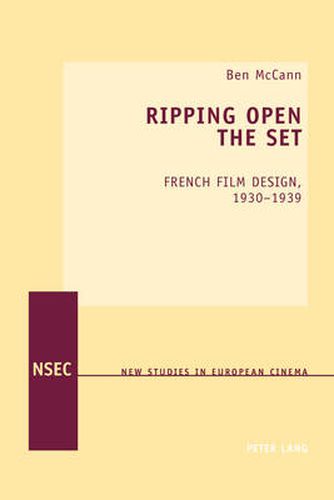Readings Newsletter
Become a Readings Member to make your shopping experience even easier.
Sign in or sign up for free!
You’re not far away from qualifying for FREE standard shipping within Australia
You’ve qualified for FREE standard shipping within Australia
The cart is loading…






This title is printed to order. This book may have been self-published. If so, we cannot guarantee the quality of the content. In the main most books will have gone through the editing process however some may not. We therefore suggest that you be aware of this before ordering this book. If in doubt check either the author or publisher’s details as we are unable to accept any returns unless they are faulty. Please contact us if you have any questions.
French film design throughout the 1930s was not just descriptive, but also expressive: sets were not merely part of the background, but were vital components of a film’s overall atmosphere, impact and critical afterlife. This was a period when sets were ‘ripped open’, as painted backdrops were replaced by three-dimensional constructions to ensure greater proximity to reality. Accomplished set designers such as Alexandre Trauner, Jacques Krauss and Eugene Lourie crafted a series of designs both realist and expressionistic that brought out the underlying themes of a film’s narrative and helped create an exportable vision of ‘Frenchness’ that influenced other European and American film design practices.
This book details the elaborate paraphrasing tendencies of French film design in the 1930s. The author explores the crucial role of the set designer in the film’s evolutionary process and charts how the rapid development of studio practices enabled designers to become progressively more ambitious. The book examines key films such as Quatorze juillet (1932), Un Carnet de bal (1937), La Grande illusion (1937) and Le Jour se leve (1939) to demonstrate how set design works at establishing time and place, generating audience familiarity and recognition and underpinning each film’s visual style.
$9.00 standard shipping within Australia
FREE standard shipping within Australia for orders over $100.00
Express & International shipping calculated at checkout
This title is printed to order. This book may have been self-published. If so, we cannot guarantee the quality of the content. In the main most books will have gone through the editing process however some may not. We therefore suggest that you be aware of this before ordering this book. If in doubt check either the author or publisher’s details as we are unable to accept any returns unless they are faulty. Please contact us if you have any questions.
French film design throughout the 1930s was not just descriptive, but also expressive: sets were not merely part of the background, but were vital components of a film’s overall atmosphere, impact and critical afterlife. This was a period when sets were ‘ripped open’, as painted backdrops were replaced by three-dimensional constructions to ensure greater proximity to reality. Accomplished set designers such as Alexandre Trauner, Jacques Krauss and Eugene Lourie crafted a series of designs both realist and expressionistic that brought out the underlying themes of a film’s narrative and helped create an exportable vision of ‘Frenchness’ that influenced other European and American film design practices.
This book details the elaborate paraphrasing tendencies of French film design in the 1930s. The author explores the crucial role of the set designer in the film’s evolutionary process and charts how the rapid development of studio practices enabled designers to become progressively more ambitious. The book examines key films such as Quatorze juillet (1932), Un Carnet de bal (1937), La Grande illusion (1937) and Le Jour se leve (1939) to demonstrate how set design works at establishing time and place, generating audience familiarity and recognition and underpinning each film’s visual style.